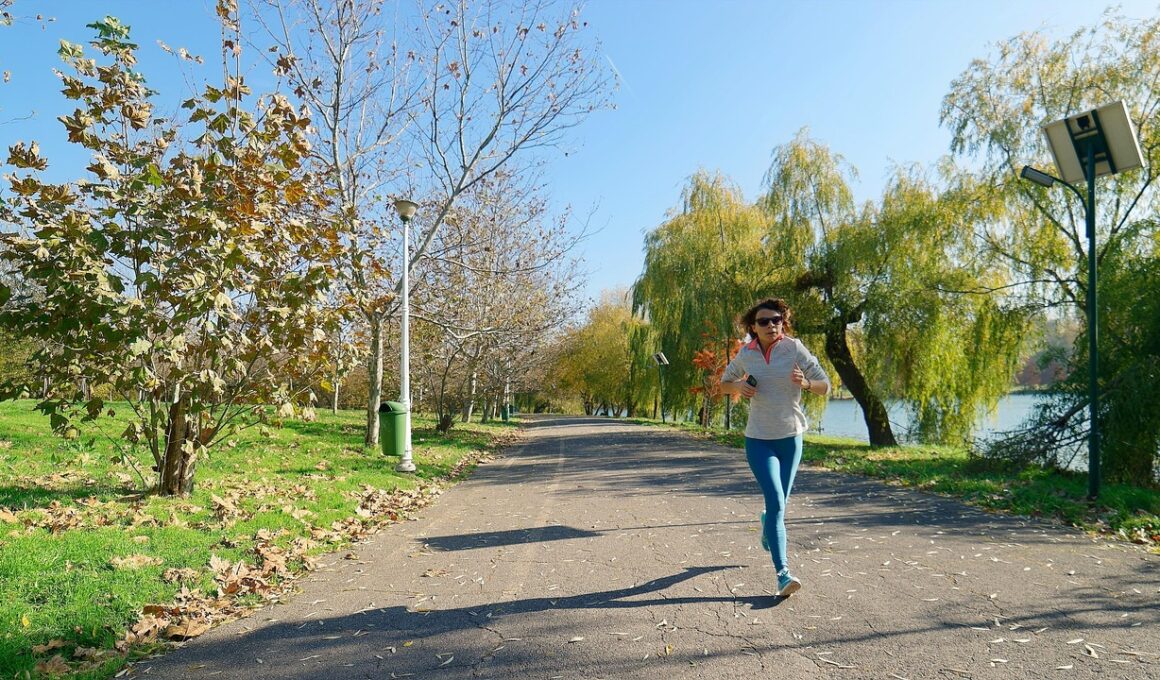Winter Warm-Ups: Preparing Your Body for Cold Weather Exercise
As the temperature drops, preparing for winter workouts becomes crucial. Cold weather can pose challenges, including muscle stiffness and increased risk of injury. Therefore, proper warming up and stretching are essential before engaging in any fitness activities outdoors. A good warm-up increases your heart rate, ensures optimal blood flow to muscles, and improves flexibility, making it safer and more effective to exercise in lower temperatures. Try dynamic stretches like arm circles, lunges, and high knees to prepare your body. Aim for at least ten minutes of warm-up to help raise your body temperature. This will ensure that both muscles and joints are ready for the challenges they will face during your workout. Be mindful of what you wear as well, opting for moisture-wicking fabrics to maintain your temperature while exercising. As you continue your winter routine, adapt to changes in your body and listen to any signs of discomfort. Remember, consistency is essential for achieving and maintaining your fitness goals even in the cold! This proactive approach will enable you to enjoy your winter workouts regardless of the temperature outside.
Incorporating short bursts of activity into your warm-up can significantly prepare your body for exercise. Begin with light aerobic exercises such as jumping jacks or brisk walking to get your heart racing. Following this, integrate dynamic stretches targeted at the muscle groups you plan to use. For example, if you’re running, implement leg swings and hip circles to loosen your lower body. Additionally, consider using resistance bands for upper body stretches, focusing on shoulders and arms. Stretching not only helps prevent injuries but also improves flexibility and performance. In winter, the risk of muscle strains increases due to the cold, making it even more important to invest time in your warm-up routine. Creating a structured warm-up can lead to better performance during workouts, whether you’re hitting the trails, lifting weights, or engaging in team sports. This structured approach can help in setting a consistent routine that prepares you mentally and physically for the activities planned. Embrace this time as an opportunity to connect with your body and prepare it for the tasks ahead, enhancing your overall exercise experience and confidence.
Choosing the Right Layers
When engaging in winter workouts, choosing the appropriate clothing layers becomes critical for optimal comfort and performance. The three-layer system is often recommended: base layers, insulation layers, and outer layers. Base layers, made from materials like polyester or merino wool, wick moisture away and help regulate your body temperature. Insulation layers create warmth, while outer layers protect your body from wind, rain, and snow. Ensuring that your clothing fits appropriately without restricting movement is equally important. Tight-fitting clothing can create discomfort during workouts and lead to distractions. Conversely, loose clothing may not provide the necessary insulation or layering benefits. Remember to consider the weather conditions and adjust your layers accordingly. If it’s cold but sunny, you may need fewer layers, while cloudy, windy conditions could warrant extra protection. Also, don’t forget about accessories! Hats, gloves, and thermal socks are essential components that can make a substantial difference in your comfort during outdoor activities. Lastly, prioritize wearing breathable and reflective clothing for safety when exercising in low-light winter conditions to stay visible while ensuring comfort and warmth.
Hydration is often overlooked in winter, but maintaining proper fluid levels is essential. While you may not feel as thirsty when it’s cold outside, your body still requires adequate hydration to function optimally. Dehydration can impair your performance and lead to fatigue, so it’s crucial to be mindful of your fluid intake, even when the temperatures drop. Start your day by drinking water, and consider bringing along a water bottle on your runs or workouts. Additionally, warm beverages can keep you hydrated and provide comfort during freezing conditions. Herbal teas or a light broth can be excellent alternatives to plain water while ensuring you stay hydrated. Pay attention to your body’s signals, and drink regularly, even if you don’t feel thirsty. The effects of dehydration can sneak up on you during colder months, especially when engaging in physical activities. Fueling your body with adequate hydration contributes to your endurance and reduces the chances of cramps or other issues. By integrating hydration into your winter fitness regimen, you’ll find it easier to stay motivated and perform at your best, ensuring that you reach your seasonal fitness goals.
Staying Motivated During Winter
Motivation can take a hit when the days get shorter and colder. To overcome the winter slump, set realistic goals that inspire you to stay active despite the weather. Consider joining a fitness class or finding a workout buddy to keep you accountable and engaged. Setting specific targets, like running a certain distance or completing a particular workout, can help track your progress and enhance your commitment. Variety is another crucial element in maintaining your enthusiasm for exercise in winter. Engage in diverse activities such as cross-training, yoga, or indoor circuits to keep things fresh and exciting. Explore new indoor venues, like local gyms or community centers, that offer winter-specific training programs. Consider utilizing technology as well; fitness apps and online videos can provide guidance and structure even when you can’t meet up with friends or trainers. Lastly, don’t hesitate to reward yourself for reaching milestones! Celebrating small achievements reinforces your commitment and reminds you of your goals, serving as a driving force for consistency in your fitness routine throughout the winter months. Maintaining motivation is a key factor in developing a sustainable and enjoyable approach to winter fitness.
As you explore outdoor activities, prioritize safety by being aware of your environment and assessing any potential hazards. Ice, snow, and wet ground can create slippery conditions that may lead to falls or injuries if you are not cautious. Always choose well-maintained paths or tracks for your workouts, especially if you enjoy running or walking. Make it a point to scout local areas before committing to new routes in winter. If you feel uncertain about conditions, opt for indoor alternatives like gym facilities or sports centers that allow you to continue your regimen without risking injury. Having a plan B can ease any concerns and make your fitness journey less stressful. Additionally, consider investing in appropriate footwear that provides traction, stability, and support in adverse weather. If you choose to run outdoors, wearing shoes specifically designed for winter conditions will enhance your grip and reduce slipping. Paying attention to your surroundings will also boost your confidence and help you maintain your fitness routine during these months, creating a better experience overall. By prioritizing safety, you empower yourself to enjoy outdoor fitness during winter confidently.
Embracing Winter Fitness
In conclusion, embracing winter fitness comes down to preparation and willingness to adapt. By prioritizing warm-ups, layering correctly, and maintaining hydration, you’ll be well on your way to an enjoyable workout in colder conditions. Winter can be a special time to experience outdoor workouts in a unique environment, as there’s beauty in the serene landscapes. Setting achievable goals and staying motivated plays a significant role in sustaining your fitness journey through these months. Don’t shy away from trying new activities; winter sports or outdoor workouts can bring excitement and refresh your routine. The key is to remain flexible and open to changing your approach to exercise as the seasons change. Remember that, while winter presents challenges, it also offers opportunities for personal growth and increased resilience. Focus on building a habit of consistency by staying active throughout the season. The commitment you make now will help you transition smoothly into your spring fitness endeavors. Ultimately, enjoy the process, take pride in your efforts, and relish the empowering feeling of maintaining your fitness during winter months.



